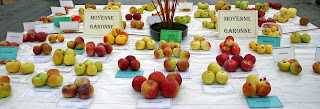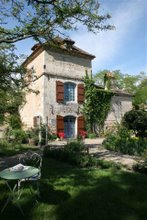‘Le Petit Bleu’, the local paper in my corner of
“Si Saint-Lambert est pluvieux, suivent neuf jours dangereux”- if it rains on April 14- St.Lambert’s day, nine ‘dangerous’ days days follow.
Or this one for the 5th of August— À Saint-Abel, Faites vos confitures de mirabelles- On Saint Abel’s make your plum jam! Like gentle reminders that there is a time and rhythm in country life, they count off the year and seasons as I live in
When I asked when to plant my hazelnut and wild plum hedgerow, my friendly Gascon neighbors all responded the same… “A la Sainte Catherine, tous bois prend
So what do a third-century virgin martyr and 2,000 heritage fruit trees have in common? The answer is a 25-acre site nestled in the rich alluvial valley of the
So take a mini-French vacation this weekend with me in Gascony and discover the French passion for a bite of old fashioned fruit.
Not long ago Mme. Leterme walked me around her fruit fief on an oriental carpet of leaf and fruit. Apples weighed heavily on sculptured boughs; semi-dwarf trees looked like some mad bonsai artist had been let loose in the orchard. There was a lone late peach variety that yield an neon peach globe, a Pêche Dur, that had great texture, like a mango and tasted of fall rather than summer- rounder, less acidic, honey juiced and …ultra-peachy. Several dozen fig varieties invited plucking; the most humble deep purple pouch, a Ronde de Bordeaux- not even as big as an egg, popped into my mouth and exploded with sweet nectar and crackling seeds. At Evelyne’s invitation, I filled my pockets with white-dotted Court Pendu Rouge de Lot-et-Garonne, a true native variety and one of the first trees I planted in my own orchard for the French Kitchen.
In the blossom spring and fruitful summer months the
Mme. Leterme tells me how she came here from the Ecomusée de la Lande having collected samplings of fruit trees as she bicycled through the Basque country protecting both genetic history and the stories of those who labored the earth. In 1996, when she arrived in the Lot-et-Garonne, it was to establish what would become the most important collection of apple trees in France. She would begin to catalogue, protect and develop more than 800 ! varieties of apples and over 1000 other varieties of sixteen other species here in quiet Montesquieu.
Mme. Leterme’s quiet passion is catching. I found myself getting excited about the 22 different hazelnut varieties, a singular collection that she saved from destruction in
Overwhelmed with choice, what would I chose for my birthday present? Symbolic and delicious, yet beautiful and productive? Et voila! As we reached the back of the 25 acre site, I spotted the perfect gift tree, bearing leathery orbs to sport like Christmas ornaments in the orchard.
And hidden within? Enough jewels to tempt a pirate queen. Arrrr mateys, there’s treasure within!
*"the Long Village"...what I call the 500 miles of canals and river that thread across France!






















3 comments:
I was just reading a book by Barbara Kingsolver, who talks about heirloom seeds and plants here in the US and how important it is for us to preserve these treasures. Sounds to me like your area of France is well ahead of us in that area.
Thanks Kate for sharing with us your trip for that special plant. I love the history of it all!
Cheers!
I was so taken up with your story that I forgot to wish you a
"Happy Birthday" and what a wonderful gift you have for yourself!
Kate ~ I have made my way to your blog from Deb's. I, too, love old varieties of fruit. I have loved quince since childhood and lament not only its short season but the fact the so few people seem to know what to do with them. The pomme d'anis is an unheard of variety for me and is one that greatly interests me. I need to do some research to see what old varitals we have available in New Zealand, though none, of course, wil be as old as the ones in South-West France.
Thanks for pointing the way to Harold McGee's similar topic.
Happy Birthday.
Post a Comment